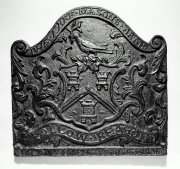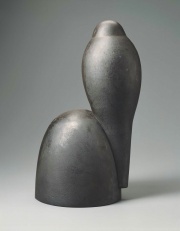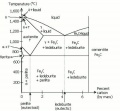Difference between revisions of "Cast iron"
(username removed) |
|||
| (4 intermediate revisions by 3 users not shown) | |||
| Line 1: | Line 1: | ||
| − | [[File:1982.618-C40302.jpg|thumb|]] | + | [[File:1982.618-C40302.jpg|thumb|Cast iron fireback<br>MFA# 1982.618]] |
== Description == | == Description == | ||
| − | An alloy of [ | + | An alloy of [[iron]] with [[carbon]] that is hard, brittle and nonmalleable. Cast iron contains about 2 to 4% carbon and 1 to 3% [[silicon]]. It was made in China by at least the 3rd century BCE. The technique for its production did not reach Europe until medieval times. Cast iron is manufactured by melting scrap iron or pig iron in a cupola that is in contact with the coal fuel, then casting the molten iron into a mold. It is inexpensive and easy to make. In the 1830s, cast iron was used for structural and decorative building components in North America. It was also used for cast iron pipe, stove pipe, firebacks, cauldrons, and cannons. |
| + | [[File:1991.620-SC16533.jpg|thumb|Cast iron sculpture<br>MFA# 1991.620]] | ||
| + | See also [[gray cast iron]], and [[white cast iron]]. | ||
| − | |||
| − | |||
| − | |||
== Synonyms and Related Terms == | == Synonyms and Related Terms == | ||
grey cast iron; gray cast iron; Gusseisen (Deut.); fonte (Fr.); gietijzer (Ned.); gjutjärn (Sven.); hierro fundido (Esp.); ferro fundido (Port.) | grey cast iron; gray cast iron; Gusseisen (Deut.); fonte (Fr.); gietijzer (Ned.); gjutjärn (Sven.); hierro fundido (Esp.); ferro fundido (Port.) | ||
| − | == | + | ==Physical and Chemical Properties== |
| − | Gray cast iron (with silicon) has less | + | * Gray cast iron (with silicon) has less tensile strength and shock resistance than steel. It is difficult to weld. |
| − | + | * The seasoning or impregnation of cast iron cookware with oil minimizes rusting. | |
| − | The seasoning or impregnation of cast iron cookware with oil minimizes rusting. | ||
== Additional Images == | == Additional Images == | ||
<gallery> | <gallery> | ||
| − | + | File:castironlargekes.jpg|Cast iron micrograph | |
| − | File:castironlargekes.jpg|Cast iron | ||
File:Phasediagironcarbonf5.jpg|Phase diagragm of iron-carbon | File:Phasediagironcarbonf5.jpg|Phase diagragm of iron-carbon | ||
</gallery> | </gallery> | ||
| − | + | ==Resources and Citations== | |
| − | == | ||
* David C. Scott, ''Metallography and Microstructure of Ancient and Historic Metals'', The Getty Conservation Institute, Los Angeles, 1991 Comment: usually 2-4 % carbon | * David C. Scott, ''Metallography and Microstructure of Ancient and Historic Metals'', The Getty Conservation Institute, Los Angeles, 1991 Comment: usually 2-4 % carbon | ||
| Line 34: | Line 30: | ||
* ''The Dictionary of Art'', Grove's Dictionaries Inc., New York, 1996 | * ''The Dictionary of Art'', Grove's Dictionaries Inc., New York, 1996 | ||
| − | * Wikipedia | + | * Wikipedia: http://en.wikipedia.org/wiki/Cast_iron (Accessed Oct. 18, 2005): 2 % carbon |
* G.S.Brady, ''Materials Handbook'', McGraw-Hill Book Co., New York, 1971 Comment: p. 155 | * G.S.Brady, ''Materials Handbook'', McGraw-Hill Book Co., New York, 1971 Comment: p. 155 | ||
| Line 48: | Line 44: | ||
* Susan E. Schur, Conservation Terminology: A review of Past & Current Nomenclature of Materials, ''Technology and Conservation'', Spring (p.34-39); Summer (p.35-38); Fall (p.25-36), 1985 | * Susan E. Schur, Conservation Terminology: A review of Past & Current Nomenclature of Materials, ''Technology and Conservation'', Spring (p.34-39); Summer (p.35-38); Fall (p.25-36), 1985 | ||
| − | * | + | * Cast iron at www.answers.com; 2.0-3.5% carbon, 1-3% silicon |
[[Category:Materials database]] | [[Category:Materials database]] | ||
Latest revision as of 08:20, 24 May 2022
Description
An alloy of Iron with Carbon that is hard, brittle and nonmalleable. Cast iron contains about 2 to 4% carbon and 1 to 3% Silicon. It was made in China by at least the 3rd century BCE. The technique for its production did not reach Europe until medieval times. Cast iron is manufactured by melting scrap iron or pig iron in a cupola that is in contact with the coal fuel, then casting the molten iron into a mold. It is inexpensive and easy to make. In the 1830s, cast iron was used for structural and decorative building components in North America. It was also used for cast iron pipe, stove pipe, firebacks, cauldrons, and cannons.
See also Gray cast iron, and White cast iron.
Synonyms and Related Terms
grey cast iron; gray cast iron; Gusseisen (Deut.); fonte (Fr.); gietijzer (Ned.); gjutjärn (Sven.); hierro fundido (Esp.); ferro fundido (Port.)
Physical and Chemical Properties
- Gray cast iron (with silicon) has less tensile strength and shock resistance than steel. It is difficult to weld.
- The seasoning or impregnation of cast iron cookware with oil minimizes rusting.
Additional Images
Resources and Citations
- David C. Scott, Metallography and Microstructure of Ancient and Historic Metals, The Getty Conservation Institute, Los Angeles, 1991 Comment: usually 2-4 % carbon
- Dictionary of Building Preservation, Ward Bucher, ed., John Wiley & Sons, Inc., New York City, 1996 Comment: 2.5-4.0% carbon
- The Dictionary of Art, Grove's Dictionaries Inc., New York, 1996
- Wikipedia: http://en.wikipedia.org/wiki/Cast_iron (Accessed Oct. 18, 2005): 2 % carbon
- G.S.Brady, Materials Handbook, McGraw-Hill Book Co., New York, 1971 Comment: p. 155
- Richard S. Lewis, Hawley's Condensed Chemical Dictionary, Van Nostrand Reinhold, New York, 10th ed., 1993
- Henry Hodges, Artifacts: An Introduction to Early Materials and Technology, Ronald P. Frye, Kingston, Canada, 1988
- Random House, Webster's Encyclopedic Unabridged Dictionary of the English Language, Grammercy Book, New York, 1997
- The American Heritage Dictionary or Encarta, via Microsoft Bookshelf 98, Microsoft Corp., 1998 Comment: 2.0-4.5% carbon, 0.5-3.0% silicon
- Susan E. Schur, Conservation Terminology: A review of Past & Current Nomenclature of Materials, Technology and Conservation, Spring (p.34-39); Summer (p.35-38); Fall (p.25-36), 1985
- Cast iron at www.answers.com; 2.0-3.5% carbon, 1-3% silicon



